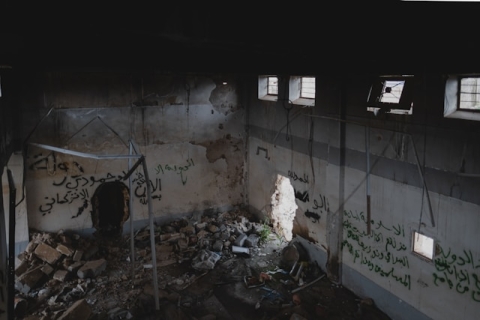

Dr Busra Nisa Sarac, Lecturer in Terrorism Studies at the University, writes for The Conversation.
Austrian authorities announced the arrest of two people on August 7 for planning attacks on large events around Vienna, including Taylor Swift concerts. The suspects, a 19-year-old who was known to security services and a 17-year-old, are Austrian citizens believed to have been radicalised by extremist Islamist propaganda from Islamic State (IS) and Al-Qaeda.
These foiled plans were followed by a knife attack in the west German city of Solingen on August 23 that killed three people and wounded eight others. IS claimed responsibility for the attack the following day.
To understand the message that IS intended to send through these attacks, we must consider how the group operated both at its peak and after its 2019 defeat, when the final stretch of the group’s territory was liberated in Baghuz, Syria.
Between 2014 and 2016, IS gained international media attention for its campaign to establish a so-called Islamic caliphate in Iraq and Syria. The group recruited men and women from over 80 countries, and committed atrocities against minorities including Kurds, Shabaks, Christians and Yazidis in the territories across Iraq and Syria that fell under its control.
A global coalition made up of 87 international partners, including countries and organisations like Nato, was established to defeat IS. Once the group had lost control of all of its territory, it saw a significant decrease in media attention. This decline in coverage occurred despite the enduring and severe consequences of the group’s actions, particularly for ethnic groups like the Yazidis.
Ten years have now passed since IS’s brutal campaign of genocide and sexual enslavement against the Yazidis in Iraq. But around 150,000 survivors still live in tents in displaced person camps, and around 2,600 Yazidis are still missing.
The loss of physical territory was a critical blow to IS’s image as a powerful and expansive entity. However, its ideological and operational capabilities were far from eradicated.
Remarkable ability to adapt
Islamic State has demonstrated a remarkable ability to adapt and persist. It has transitioned from a centralised territorial structure to a more clandestine network of decentralised cells operating mainly in sub-Saharan Africa, still capable of orchestrating and inspiring attacks across the globe.
Some of these attacks have been extremely high profile. In 2021, groups affiliated with IS launched an attack on the Al-Sina prison in Syria to free fellow militants.
The ensuing battle with the Syrian Democratic Forces (a militia in the north-east of the country led by US-backed Kurds) lasted for ten days and left more than 500 people dead. There is no consensus on the number of IS members who managed to escape the prison, but it is believed to be somewhere between 30 and 300.
Then in March 2024, the group’s south-central Asia branch, Islamic State-Khorasan, attacked the Crocus City Hall concert venue in Moscow. This incident underscored the ability of IS to strike far beyond the Middle East.
IS may seem less menacing now than in its heyday. But these attacks, and others, serve as stark reminders that, despite the loss of its caliphate, the group remains a potent threat that is continuously seeking to project power and spread fear around the world.
The foiled attacks on Taylor Swift concerts tell us several things. First, that IS can still plan attacks anywhere, often using people radicalised at home without sending operatives abroad. This indicates the group’s ideology remains alive, and that young people are still vulnerable to its violent extremist narratives.
Second, the choice of Swift’s concerts was strategic. An attack on such a high-profile event would have garnered significant international media attention, potentially aiding recruitment. Indeed, the group may already have achieved part of its objective — gaining media attention — simply by planning the attack.
And third, it is worth considering the potential misogynistic element of the planned attacks. Similar to the bombing of an Ariana Grande concert in Manchester in 2017, this attack was planned against a female singer whose concerts are predominantly attended by young women and girls.
These incidents highlight the extreme patriarchal political and social order promoted by IS, which dictates the roles and positions of women and men within the group. This gendered ideology has motivated violence and has served as a means to advance its brutal agenda ever since IS emerged in 2014.
Tackling the threat
Vienna has experienced terrorism before – the city faced an attack in 2020 that killed four people. But the recent foiled attacks highlight ongoing issues of on- and offline radicalisation, manifesting across various ideologies and beliefs.
Those susceptible to radicalisation are not confined to a specific age group. While young people are often highlighted as being particularly at risk, people of all ages can be vulnerable to extremist influences, driven by a variety of personal, social, political and ideological factors.
States cannot afford to become complacent despite the territorial defeat of IS – or any terrorist group. They should continue to focus on those vulnerable to radicalisation, without stigmatisation.
Busra Nisa Sarac, Lecturer in Terrorism Studies, University of Portsmouth
This article is republished from The Conversation under a Creative Commons license. Read the original article.
More articles from The Conversation...
Prison is a disaster for women – here’s what would work instead
April Smith
16 August 2024
9

Increasing numbers of sexual offences on public transport recorded – but many experiences are still normalised and go unreported
21 August 2024
7

It’s almost impossible to become an Olympic athlete without overtraining — here’s why
7 August 2024
6 min read

